Science is a lot of fun with hands-on activities
Yoshio Kamishina
Abstract
A boring science class could be changed into
one that is full of fun with hands-on activities. Some
examples of such activities are demonstrated. These are
integrated with subjects like physics and music. The themes
of hands-on activities here are limited to mechanical resonance
phenomena and characteristics of rotational motion. |
1. INTRODUCTION
The lecture demonstration used to be - and in many
countries still is - central to school science teaching, but it has
now been replaced in many schools with the ubiquitous class experiment.
Traditional science museums contain collections of,
usually old, scientific and technological objects, often enclosed
in glass cases, with concise notes explaining their origins and significance.
The visitor is expected to walk around, to look, to absorb the information
and to move on. The visitor's role is passive, and there is no opportunity
to interact with the exhibits. These museums are worthy of conservation.
However, many museums are developing a hands-on science section or
are changing into interactive science museums.
In a primary school, where an integrated approach to
curriculum has been adopted, the subject of science does not exist
in isolation. Subjects in the curriculum are not limited by boundaries;
rather it is the interdependency of subjects, which is utilized in
the learning process. Even in secondary schools, an integrated approach
to curriculum can also effective. In the present paper, some examples
of hands-on experiments, which integrate physics and music, and physics
and play are described.
2. RESONANCE PHENOMENA
2-1. A toy frog swing
| In our daily lives, phenomena of resonance
are commonly observed. First, a tricky experiment that is a feat
of magic using conical pendulums. Three different conical pendulums
are hung from the same bar with their symmetry axis on a vertical
line ( Fig.1). Each pendulum is of different length, and therefore
has a different natural frequency. You can cause any one of the
pendulum bobs to swing while the other two remain at rest. The
trick is very simple. When you move the bar gently forward and
backward at the same frequency as that of the pendulum you want
to move, only this bob will swing. The others will not move.
This is a simple example of resonance phenomenon. |
 |
|
Fig. 1. Three
sets of conical pendulums. |
| Second, a toy frog swing. I have developed
a model that represents the movement of a real swing as closely
as possible by using a toy rubber frog (Fig.2). The legs are
made of rubber and fold so that the frog is in sitting position
when the air pressure is low in the body of the frog (Fig.3).
When air is pumped into the body through a plastic tube inside
the hanging rope, the frog stands up on the seat due to the higher
air pressure in the legs (Fig.4). |

|
|
Fig. 2. A
toy frog swing |
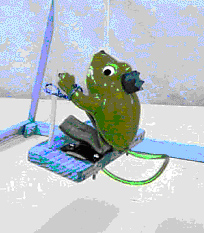
|

|
Fig. 3. A
sitting frog on the seat |
Fig. 4. A
standing frog on the seat |
In this way, you can propel the frog to swing by working
a rubber pump. The swing is driven by air pressure through the fine
tube connected to the rubber ball pump. When you press the pump,
the toy frog stands up on the seat and the length of rope is effectively
shortened. A swing can be thought of as a kind of pendulum, and it
has own natural frequency determined by the length of the rope. So,
if you gently push the back of the frog, the swing rider, at the
same frequency as the natural one of the swing, the amplitude of
the swing's movement gets larger and larger. This is also a resonance
phenomenon. Remember the movement when you played on a swing. You
just repeat standing up and sitting down on the seat. Even if nobody
pushed you, you could propel the swing by timely up and down movements.
Changing the length of the rope, that is the parameter of the system
that determines the natural frequency, energizes the swing. This
kind of excitation is called parametric. The characteristic of parametric
excitation in a swing is that the frequency of excitation, that of
pressing the pump in our case, is twice the natural frequency of
the swing. When you press the pump twice in a swing cycle, the frog
is most energized. Needless to say, you have to press the pump in
phase with the frog? swinging. If you do it out of phase, the amplitude
of the swing gets smaller and the swing finally stops.
2-2. Musical instruments
| Other good examples of resonance phenomenon
are various kinds of musical instruments. All non-electronic
musical instruments make use of resonance phenomena to amplify
the sound volume.
However, here we will discuss only wind instruments.
First, a pipe tuning fork is used to demonstrate sound resonance
phenomena. A pipe tuning fork is made of a square metal pipe
with one end shaped like a tuning fork (Fig.5). For the purposes
of this demonstration, I prepared two pipe tuning forks.
The lengths of the tuning fork parts are the same; therefore
the pitch of the sound will be the same. However, the lengths
of the rest of the pipes are different. When you hit the
longer tuning fork with the end of pipe open, the sound is
loud, and if you close the end of pipe, the volume decreases.
On the other hand, when you hit the shorter pipe tuning fork
with the end of pipe open, the sound is small, and when you
close the end of the pipe the sound gets loud. These two
pipe tuning forks clearly show the difference of the resonance
conditions of an open-end pipe and a closed end pipe. A semi-quantitative
explanation of the difference is as follows. Let the sound
velocity be v, the length of the pipe L, the frequency of
the sound in resonance with the pipe f, that is the pitch
of the sound. The simple theory ignoring the open end correction
of the resonance condition of sound in the pipe tells as
follows. The resonance condition is given by the formula
f = v / 2L for an open-end pipe, while f = v / 4L for a closed
pipe. The length of the shorter pipe is adjusted as the sound
is loud when the end of the pipe is closed, while that of
the longer one is adjusted as it is loud when open for the
same pitch of sound. |
 |
|
Fig. 5. A
pair of pipe tuning forks |
| Next, the principle of making sound
in wind instruments. In a wind instrument, the sound is a vibration
of air column in the instrument. Wind instruments are roughly
grouped into three families: the oboe family, the trumpet family
and the flute family. In oboe type instruments, blowing and vibrating
a reed or double reeds make the sound. Clarinets and saxophones
belong to this family. A model of a reed instrument can be easily
made using a plastic drinking straw and a small piece of overhead
projector transparency sheet. You can verify that the pitch of
the sound gets higher when you shorten the straw. In the trumpet
family, sound is made by the vibrating lips of the player, pushed
against the mouthpiece (Fig.6). So, it is rather difficult to
make sound. Trombones and French horns belong to this family.
In the flute family, sound is made by blowing against the edge
of the hole in the side of the pipe. There are many kinds of
flutes such as bass flutes, alto flutes, piccolos, fifes, recorders
and Pan flutes. A model of a Pan flute can be made using a set
of test tubes made of glass or plastic (Fig.7). You can change
the pitch of each tube by changing the length of air column in
the tube. |

|
|
Fig. 6. Mouthpieces
(left: trumpet, right: trombone) |
| In all musical instruments, pitch
of sound varies when you change the length of the pipe. The method
of changing the length is different depending on the type of
instrument. A trombone is straightforward. In flutes, recorders,
oboes, and so on, you change the length of the pipe by closing
and opening holes in the pipes. The lengths of the vibrating
air columns in trumpets and French horns are manipulated valves
that add or subtract segments |
 |
|
Fig. 7. A
model Pan-flute |
3. CHARACTERISTICS OF ROTATIONAL MOTION
| 3-1. A top
A top is one of the most popular toys not only
for children but also for adults (Fig.8). Why does a top
fall down so easily when it is not spinning, while it is
in a very stable state when it spins fast? It is a natural
question. However, it is rather difficult to answer for primary
school pupils and even secondary school students. To understand
the mechanism of the stability of a rotating top, you have
to learn about the concepts of Angular Momentum, Torque,
Conservation of Angular Momentum, Moment of Inertia, and
so on. These concepts are too difficult for children to understand.
So, I tried to answer the question without using these difficult
concepts and mathematics. Instead, I used many demonstration
and hands-on experiments to help the students understand
these concepts through experience. |

|
|
Fig. 8. A
conventional Japanese top |
| The center of mass
The lower the center of mass of an object, the more
stable it is when at rest. However, this is not the case
when an object is moving. It is not necessarily stable when
its center of mass is in the lowest position. For example,
think of a simple pendulum. The bob swings and the center
of mass goes up and down periodically, and the average position
of the center of mass is higher than when the pendulum is
at rest. As another example, I showed a couple of bobs connected
by a string through a short tube. Hold the tube vertically
and keep the upper bob on the tube, with the other bob hanging
by the string connected to the upper bob. When these bobs
are at rest, the lower bob stays at the lowest position and
this form is the most stable. If you rotate the upper bob
in the horizontal plane, the lower bob rises as the upper
bob moves faster, and the center of mass of the system is
also lifted, which means that motion raises the center of
mass of the system. |
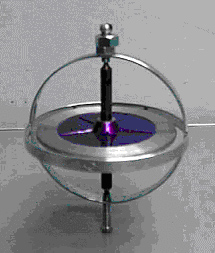
|
|
Fig. 9a. A
gyroscope |
| Angular momentum and torque
The physical quantity characteristic of rotational motion
is angular momentum L, which is defined as L = r x P, where
r is the position vector relative to a point in space, P
is the linear momentum, and x is the cross product (vector
product). If there is no external force exerted on a system,
angular momentum is conserved, and therefore, the direction
of rotating axis does not change. To understand this law
qualitatively, I showed an improved gyroscope. In this improved
gyroscope, another axis perpendicular to the rotating axis
is attached to the outer frame of a usual gyroscope (Fig.9a,
9b). When you suspend the improved gyroscope from chains
or strings at the attached axis, it is held effectively at
the center of mass against gravity. As a result, neither
gravity nor other external force is acting on it. In this
situation, when you spin it rapidly, the direction of the
rotational axis never changes even if its frame is moved
at random. This is because of conservation of angular momentum.
Most students are surprised and impressed by this phenomenon.
They should recognize it as a characteristic of rotational
motion. Next you set the rotational axis of a rapidly spinning
improved gyroscope in the horizontal plane and hang a weight
at one end of the axis. The axis still remains in the horizontal
plane and rotates around the vertical line. If the procedure
is repeated while the gyroscope is at rest, the axis drops
as soon as the weight is attached. The force acting on the
rotational axis is perpendicular to both the direction of
gravity and that of the rotation axis. This kind of force
is called a torque, and the motion is called precession from
an astronomical term. Students should understand this as
another characteristic of rotational motion. That? why a
rapidly spinning top hardly falls down as the rotational
axis rotates around the vertical axis, that is a precession. |
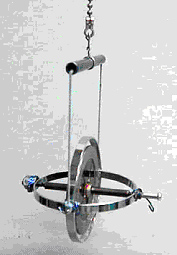
|
|
Fig. 9b.
An improved gyroscope |
| 3-2. A tippy top
Among a variety of tops, a tippy top is most
popular. At a glance, a tippy top is hardly distinguishable
from normal tops (Fig.10a, 10b). A top usually
rotates steadily around the rotational axis and the rotational
axis rotates around the vertical axis as everyone knows.
However a tippy top turns upside down while rotating (Fig.11).
The big difference between them is that the usual top falls
down when at rest while a tippy top doesn't. It is stable
at rest. This means that the center of mass of a conventional
top is situated higher and it is therefore unstable at rest,
while on a tippy top the center of motion is at the lowest
position at rest. Roughly speaking, rotational motion progressively
lifts the center of mass of a tippy top, and finally turns
it over. The mechanism by which the axis of rotation gradually
moves up or down in addition to a precession, moving in a
circular cone about the vertical axis, is in large part connected
with the action of friction at the point of contact with
the floor. |
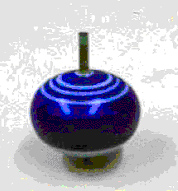
|
|
Fig. 10a. A
normal top (spinning) |
| The quantitative explanation of this
mechanism is too difficult for students to understand. The qualitative
explanation is more suitable for children. To reproduce the motion
of a tippy top, I showed a 2-dimensional tippy top consisting
of a large ring and a small ring both made of metal wire (Fig.12).
The two rings are attached at a point with the small ring inside
the large one on the same plane. The role of the smaller ring
is to shift the center of mass of the system away from the center
of the large ring. When you rotate the large ring around the
vertical axis connecting two centers of both rings with the small
ring at the bottom, the system acts like a tippy top. While when
you do the same thing but with the small ring at the top it acts
like a conventional top. The difference in behavior is the position
of the center of mass of the system. |
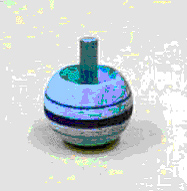
|
|
Fig. 10b. A
tippy top (at rest) |

|

|
Fig. 11. A
tippy top (spinning) |
Fig. 12. Two-dimensional
tippy top |
4. CONCLUSION
Physics toys are very good teaching tools. If you make
practical use of them and give children proper explanations about
the reasons for the behavior of the toys, most children will have
fun with physics. It is very important for children to handle the
toys themselves. They learn to understand physical concepts not only
by reading books and listening to lectures but also from their experiences
in daily life. For elementary school pupils, the latter learning
method is much more prevalent, and they very often have misconceptions.
However, it is worthwhile to mention that preconception is not misconception.
Teachers should lead them to scientific conception from non-scientific
preconception. As a useful teaching strategy, teachers should offer
children proper toys as teaching materials, and let them have first
hand experience. Most importantly, children must feel that science
is a lot of fun.
Hands-on experiments are really instructive in science
education especially for elementary and secondary school pupils.
Yoshio Kamishina is at the Department of Physics,
Faculty of Education, Shimane University 1060 Nishikawatsu-cho,
Matsue city, Shimane 690-8504 Japan
|